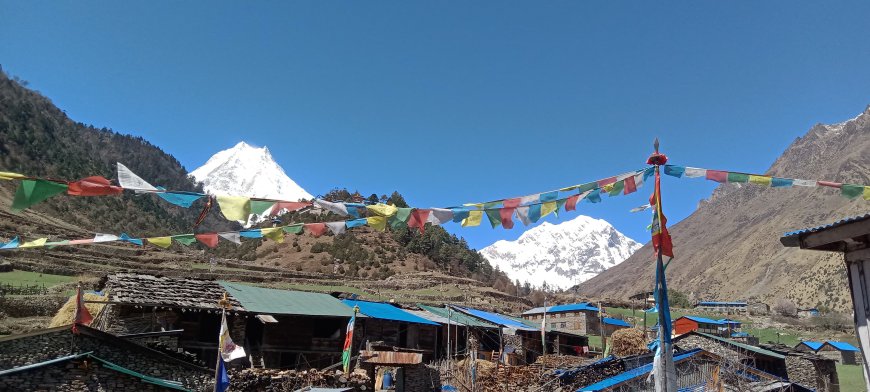How to Stay in the Annapurna Circuit Trek to Avoid Serious Damages
Stay safe on the Annapurna Circuit Trek with tips on altitude acclimatization, hydration, proper gear, and avoiding risky trails. Learn how to prepare physically, pack essential safety gear, and plan for emergencies to prevent serious health issues and injuries.

How to Stay in the Annapurna Circuit Trek to Avoid Serious Damages
The Annapurna Circuit Trek has some amazing views, but it also comes with real risks if you're not careful. One big concern is altitude sickness, which can get serious if you don't pay attention to it. To stay safe, you need to acclimate properly. That means going up slowly and taking rest days so your body can get used to the thinner air. If you rush it or gain altitude too fast, you might start feeling badthink headaches, nausea, dizziness, or worse. Trust your body and dont hesitate to head back down if you need to.
Staying hydrated and eating right is just as vital for your health on the trek. Dehydration can make altitude sickness worse and drain your energy, making you more prone to getting hurt. Drink plenty of water, eat balanced meals, and steer clear of alcohol and too much caffeine to keep your strength up. Good hydration and nutrition also help you recover on rest days and keep your immune system strong in the tough mountain conditions.
Wearing the right gear is key to avoiding injuries. Invest in sturdy, well-fitting boots with good support to prevent sprains and falls on rugged paths. Dress in layers so you can adjust to the changing temperatures, which can swing from hot to freezing. Bring rain gear and warm clothes for the sudden weather shifts that often happen in that area. Trekking poles can give you extra stability and help ease the pressure on your joints, making it easier to navigate tricky spots.
Finally, stick to well-marked trails and consider hiring a licensed guide or porter for extra safety. Guides know the trails well and can spot early signs of health issues or help you steer clear of dangers. They also manage the logistics, so you can save your energy for the hike. Keep an eye on the weather forecast and be ready to change your plans if needed. By planning smart, pacing yourself, and respecting the mountain, you can reduce risks and have a safe, memorable trip on the Annapurna Circuit.
**Know What to Expect on the Trek**
Trekking the Annapurna Circuit comes with its share of risks. You should be aware of things like altitude sickness, changing weather, rough paths, and the possibility of landslides. Some parts of the trail are pretty remote, so you might not be able to get medical help right away. You need to be both physically and mentally ready, especially when tackling steep climbs or long days of walking. Understanding these challenges ahead of time helps you prepare better and have realistic expectations. Its also important to recognize signs of altitude sickness and know when you might be getting dehydrated or fatigued. Be aware that some areas are isolated, which can make communication tough. Having a plan for emergencies is a good idea. Accepting these risks and being mentally prepared can make your trek safer and more enjoyable.
**Get Fit Before You Go**
Being in good shape is key to enjoying the Annapurna Circuit trek. The tough terrain demands good endurance, leg strength, and stamina. Its best to start training months before your trip, focusing on hiking, running, cycling, or stair climbing to build that endurance and strength. Adding in some strength training and flexibility exercises can help you avoid injuries. Practicing with a loaded backpack will give you a taste of what itll be like to carry your gear over long distances. Staying active also helps your body get used to the physical demands of trekking. Being fit can help you feel less tired, make adjusting to the altitude easier, and boost your confidence on the trail, making for a safer and more fun experience.
**Pack the Right Safety and First Aid Gear**
Taking the right safety and first aid gear on the Annapurna Circuit trek is super important. Since its in a remote area with limited medical help, an essential first aid kit should include bandages, antiseptics, pain relievers, altitude sickness meds, and any personal prescriptions. A portable oxygen cylinder might come in handy for severe altitude sickness. Trekking poles are great for balance and can lower the risk of falls. Its also smart to bring emergency blankets and whistles just in case of accidents or if you end up staying outside unexpectedly. A reliable headlamp, some sunscreen, and insect repellent can protect you from different hazards. Having the right gear helps you deal with minor issues and emergencies, making your trek safer.
**Stick to Acclimatization Guidelines**
Getting used to the altitude is really important to avoid sickness on the Annapurna Circuit. Going up slowly and giving your body time to adjust can drastically lower your chances of getting sick. A solid rule is not to sleep at a higher altitude than 300-500 meters each day once youre past 3,000 meters. Taking breaks or acclimatization days where you stay at the same height or hike higher and then come back down to sleep can help. Pay attention to how you feel and dont ignore symptoms like headaches, nausea, or dizziness. Staying informed about altitude sickness and reacting quickly if things get worse can prevent serious health issues. Following these tips can help ensure a smoother and safer trek.
**Stay Hydrated and Eat Well**
Staying hydrated and well-fed is crucial to feeling good on the Annapurna Circuit trek. Dehydration can make you feel tired and more prone to altitude sickness, so aim for at least 3-4 liters of water each day. Using purification tablets or filters will help you drink safely. Eating balanced meals full of carbs, proteins, and fats will help with energy and recovery. Quick snacks like nuts, energy bars, and dried fruit can give you a boost on the trail. Try to limit alcohol and caffeine since they can dehydrate you. Keeping up with hydration and good nutrition supports your stamina, helps avoid muscle cramps, and makes it easier for your body to adjust to the altitude. This way, you can perform better and stay healthier overall.
**Choose Reliable Places to Stay and Get Some Rest**
Finding a good place to stay while trekking the Annapurna Circuit is key for staying safe and feeling comfortable. Look for teahouses or lodges with solid reviews and good hygiene practices to help you avoid getting sick. Make sure to rest well each night to bounce back from the hike and adjust to the altitude. Your sleeping area should be warm and dry, so think about bringing a decent sleeping bag for cold weather. Try to steer clear of crowded or stuffy rooms to lower the chances of catching a cold. Pick spots that serve nutritious meals and have clean drinking water. Taking care of where you sleep and eat can affect how you feel and how much energy you have for your trek.
*Avoid Risky Shortcuts and Unsafe Paths**
While on the Annapurna Circuit, its really important to stick to the marked trails and to avoid any risky shortcuts. Taking unmarked paths can lead you into dangerous spots with steep drops or areas that can slide or have avalanches. The weather can change quickly and make these trails unsafe. Sticking to well-known routes also makes it easier to get help if needed. Local guides and good trekking maps can offer safe route info. Choosing safer paths helps keep you from getting lost or running into unexpected problems. Staying patient and cautious while trekking helps keep you and everyone else safe, letting you finish the trek without any mishaps.
**Keep an Eye on the Weather and Plan**
The weather in the Annapurna region can shift quickly, so its smart to keep an eye on forecasts for a safe trek. Sudden storms, heavy rain, or snow can make trails slippery and unsafe. Watching the weather updates can help you schedule your hikes and rest days to avoid bad conditions. Dress in layers and pack rain gear to stay comfortable through temperature changes or rain. Being ready to change your plans due to bad weather can help prevent accidents or health issues like hypothermia. Being flexible with your schedule lets you adapt without stress. Staying aware of the weather is crucial for a fun and safe trekking experience.
**Travel with Experienced Guides or Groups**
Trekking the Annapurna Circuit with experienced guides or in a group can boost safety and make the experience more enjoyable. Guides know the area well, including the terrain, weather, and what to do in emergencies, helping you navigate smoothly. Theyre also trained to spot early signs of altitude sickness or other health problems and can react quickly. Being in a group provides support, lowers the risk of accidents, and makes handling emergencies simpler. Guides can also help with communication, booking places to stay, and negotiating prices. Having experienced guides can ease worries, especially if its your first trek, giving you extra support along the way.
**Have Emergency Contacts and Evacuation Plans Ready**
Its super important to have emergency contacts and evacuation plans set for your trek around the Annapurna Circuit. Being in a remote, high-altitude area means that getting medical help quickly can be tough. Make sure you have a fully charged mobile phone or satellite phone with a local SIM for communication. Know the contact info for rescue services, trekking companies, and hospitals nearby. Let your guide or trekking group know your plans and keep them updated on where you are. Understand the evacuation routes and what to do in an emergency, whether thats for a medical issue, injury, or natural disaster. Being prepared can really make a difference and cut down the stress during your trek.
Whats the mortality rate for the Annapurna Circuit?
The Annapurna Circuit has a pretty low mortality rate, about 0.003% each year. Out of around 170,000 trekkers, only about 3 to 5 deaths happen annually, usually from altitude sickness or sudden weather changes. While the trail is mostly safe, there are still risks at high altitudes, especially near Thorong La Pass. With the right acclimatization and some caution, most trekkers make it through just fine.
Whats the hardest part of the Annapurna Circuit?
The toughest part of the Annapurna Circuit is the climb to Thorong La Pass, which stands at 5,416 meters (17,769 feet). The air thins out, making it harder to breathe, and altitude sickness can hit. The steep incline, chilling temperatures, and potential snow or wind make this section a real challenge. Trekkers usually head out early to get over the pass before the afternoon winds and poor weather kick in.
How many people have died on the Annapurna Circuit?
Numbers change each year, but generally, around 3 to 5 trekkers die yearly on the Annapurna Circuit. This can be due to altitude sickness, falls, or rough weather. A big tragedy in 2014 saw over 40 people lose their lives in a sudden blizzard. Such events are rare, but they remind us how important it is to prepare, pay attention to the weather, and practice safe trekking.
How to get ready for the Annapurna Circuit:
Getting ready for the Annapurna Circuit is all about building your fitness, planning your gear, learning about the route, and the Annapurna Base Camp Trek Package. Start working on your cardio with some hiking, jogging, or cycling a few months before. It's also good to do some strength training since you'll be carrying a pack and dealing with steep climbs. Do your homework on the trail, make a plan for how to acclimatize, and dont forget to sort out your permits. Pack light and choose gear that suits the weather. You might want to think about getting a local guide or porter to help you along the way.






































